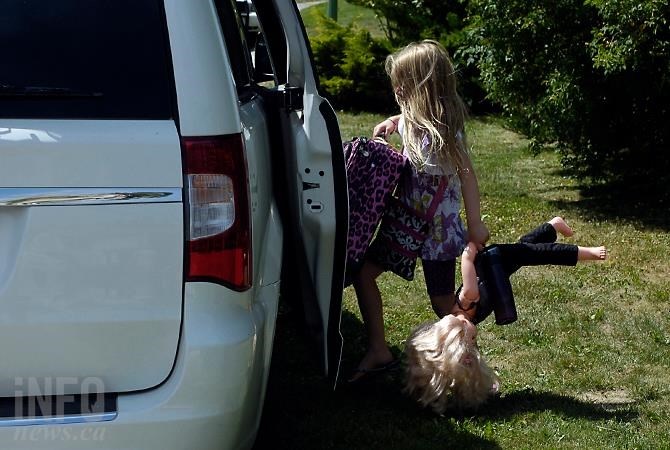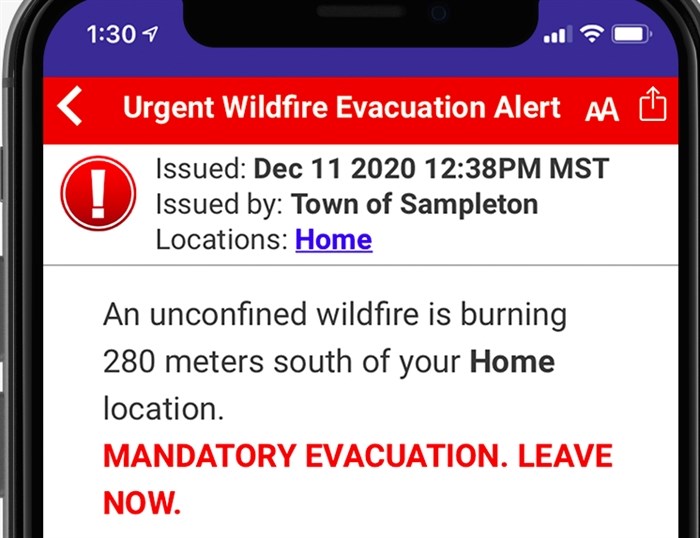
FILE PHOTO
(ADAM PROSKIW / iNFOnews.ca)
August 28, 2021 - 8:00 AM
If the White Rock Lake wildfire had started in Alberta instead of B.C., residents would have had an hour or two more to pack up and leave.
“Alberta has an alert system that comes on the phone,” Dean Hampton, an Alberta resident with a summer home at Parkers Cove on the west side of Okanagan Lake, told iNFOnews.ca.
“It would have been nice if there was one (in B.C.) because it would have given us a little bit more time to gather up a few more things,” Hampton said. “In today’s world, everybody carries a cell so next thing you know, you’ve got alerts coming to you and you know exactly what’s going on within moments.”
As it was, a friend in Vernon heard through the media that the area was on evacuation order and phoned the Hamptons to let them know. It wasn’t until about an hour later that fire officials arrived to tell them they had to leave.
They had just arrived for their vacation and still had about two hours to repack to leave. But more time would have allowed them to get their boat out of their garage and safely into Okanagan Lake.
In the end that area was not hit by fire, and their home and boat are safe.
But it got them wondering why there isn’t a provincewide alert system in B.C., the only province in the country without one.
“The province currently uses Alert Ready’s broadcast intrusive alerts for tsunami warnings,” Emergency Management B.C. said in an email. “It can also be used by RCMP for Amber Alerts and civil emergency events.”
The email notes the system has never been used by police in B.C. and local governments have their own alert systems. The agency would not say why there is no provincewide system or when there might be one.
Alberta was the leader on this issue following a tornado that hit Edmonton in 1987. That led to the creation of an emergency alert system in 1992 that has evolved into what is now called Alberta Emergency Alert.
There is also a federal alert system.
Both have the ability to send intrusive alerts to all cell phones, accompanied by loud buzzing noise. They can also interrupt TV and radio broadcasts, and notify media.
Alberta Emergency Alert is used for a wide variety of events, from missing children to wildfires and is regionalized so not everyone gets all alerts.
Critical alerts can go automatically to cell phones while other alerts may only go to those who download an app.
“To our knowledge, Alberta has the most mature alerting system in the country,” its Municipal Affairs ministry said in an email. “There are numerous emergency public alerting vendors available to create a system for any jurisdiction (municipal, provincial or federal) should the jurisdiction be interested.”
One of the major vendors is Voyent Alert! which covers about 40 per cent of B.C.’s municipalities and is used by many regional districts, including Thompson-Nicola for the last two years, and it’s just taking on Okanagan-Similkameen.

This is a sample emergency alert notice.
Image Credit: SUBMITTED/Voyent Alert!
“The federal and provincial systems do a great job at that initial alert,” Voyent Alert! president and CEO Brian McKinney told iNFOnews.ca. “After that happens, there’s a definite need for providing information to community members both during and after the alert part, throughout that whole event life cycle.”
He does work with senior governments and can monitor the effectiveness of their systems but mostly works with smaller communities and in rural areas, especially those without good cell phone reception that can’t be reached by a provincials alerts that only send text messages.
Had B.C. used the same system as Alberta, Hampton’s phone would have buzzed and notified him that he was under evacuation order, likely with links to sites where he could get more detailed information.
But communications need to continue far beyond sounding the initial alarm, McKinney argued.
Just as Logan Lake was a model for protecting itself from wildfires, it is also a great example of how to communicate with affected residents.
READ MORE: Logan Lake has written the Fire Smart playbook for other cities, towns to follow
“They did some of the best work we’ve ever seen in terms of keeping the community updated with twice daily updates through the system and keeping everybody apprised of what was going on with their properties,” McKinney said. “When the emergency alert was rescinded, everybody got an information package through the system advising them what to expect, the issues to look out for on their return, key contact information. It was a really thorough and excellent job they did.”
Notifications included things like warnings that bears were active in the community, and that some hotels and apartments had suffered water damage from sprinklers.
Lytton signed onto Voyent Alert! shortly after it was almost completely destroyed by fire earlier this summer and the town moved into recovery mode.
READ MORE: Damage estimate for fire razed town of Lytton, B.C., reaches $78 million
“They’re keeping connected with all residents on a regular, daily basis,” McKinney said. “What paperwork’s going on next, imagery and photos and links to key elements of web sites for follow up”
Other communities send links to videos so residents can actually see what happened to their properties.
“Getting people up and out is important but it’s one step of many during these events,” McKinney said.
Since the provincial system can intrude into phones and broadcasts, it’s a vital component of the warning system.
It does not send messages to land lines where there is no cell service, or send emails. Just text messages.
Commercial companies like Voyent Alert! fill that void but people have to sign up for the free app first.
In the Thompson-Nicola Regional District, only about 2,000 people had signed on since Voyent Alert! was implemented about two years ago. That jumped to 30,000 in a two-week period during wildfire season this summer.
Kamloops is now linked to that system as well.
McKinney noted that there can be jurisdictional issues between municipalities and regional districts with some cities not allowing regional districts to send messages to its residents. Those differences have been resolved with Kamloops.
Some communities use the alert system for much more than alerts, sending updates on things like park closures or promoting economic development.
When people sign up they can be quite specific about what kinds of information they get and can even set it up so they can be notified of what’s happening in other areas.
“If there’s a gas leak in your community, you might receive an alert that says your mom’s house is located 500 metres northwest of the gas leak and this is your preferred evacuation route,” McKinney said.
“Because we have access to a broader payload of information, you’re going to get a lot of precise maps. You’re going to get a picture that says: here’s where your house is and it’s in the middle of the evacuation alert area. You don’t have to read this 40-line document to figure out if you need to be moving or not. We’re in the position where we can provide you with exit route information so you can look at your phone and you can see the green line on the map indicating this is your evacuation route.”
No such system is in place in the Regional District of the Central Okanagan.
Instead, local authorities relied on a media tour of the burned-out area around Killiney Beach and a virtual town hall meeting to get information out to the affected residents, many of whom were not happy with the lack of information.
READ MORE: North Westside residents angry at lack of communication from fire officials
Implementing such a system doesn’t carry a big cost.
The Regional District of Okanagan-Similkameen is in the process of switching to Voyent Alert! as its current carrier, Civic Ready, is pulling out of Canada.
That’s costing that region $18,000 a year for an unlimited number of messages.
READ MORE: Alert system in South Okanagan regional district getting replaced
McKinney can’t say why the Province of B.C. hasn’t implement its own system – and the province certainly isn’t answering that question.
There was a request for proposals issued two or three years ago but that didn’t go through and, with COVID, it seems to have been pushed to the back burner, McKinney said.
But he has been approached by the province more recently and knows there’s some strong interest there.
When the White Rock Lake wildfire tore into the Killiney Beach area on Aug. 15, firefighters, knowing they couldn’t save every home, went into some to bring out valuables left behind by residents.
If those people’s phones had buzzed an hour or two before people arrived on foot to tell them to leave, those precious pictures and other valuables might have already been saved.
To contact a reporter for this story, email Rob Munro or call 250-808-0143 or email the editor. You can also submit photos, videos or news tips to the newsroom and be entered to win a monthly prize draw.
We welcome your comments and opinions on our stories but play nice. We won't censor or delete comments unless they contain off-topic statements or links, unnecessary vulgarity, false facts, spam or obviously fake profiles. If you have any concerns about what you see in comments, email the editor in the link above.
News from © iNFOnews, 2021